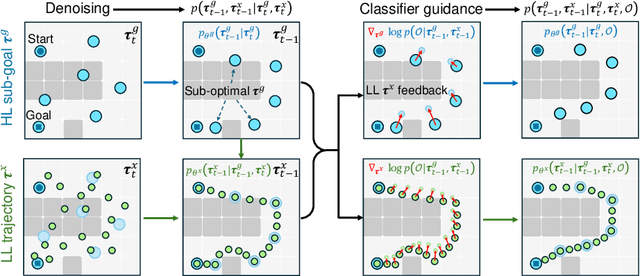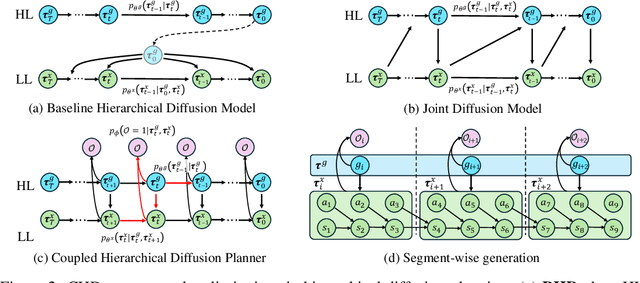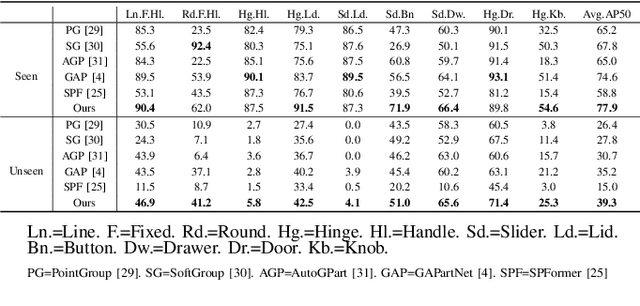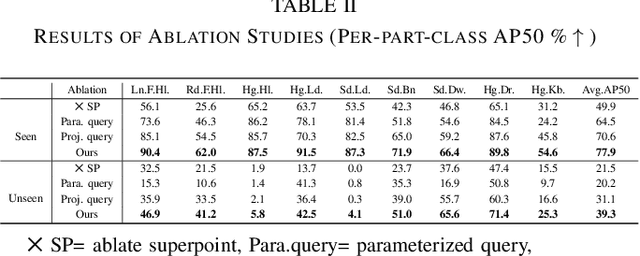Ce Hao
Hybrid Consistency Policy: Decoupling Multi-Modal Diversity and Real-Time Efficiency in Robotic Manipulation
Oct 30, 2025Abstract:In visuomotor policy learning, diffusion-based imitation learning has become widely adopted for its ability to capture diverse behaviors. However, approaches built on ordinary and stochastic denoising processes struggle to jointly achieve fast sampling and strong multi-modality. To address these challenges, we propose the Hybrid Consistency Policy (HCP). HCP runs a short stochastic prefix up to an adaptive switch time, and then applies a one-step consistency jump to produce the final action. To align this one-jump generation, HCP performs time-varying consistency distillation that combines a trajectory-consistency objective to keep neighboring predictions coherent and a denoising-matching objective to improve local fidelity. In both simulation and on a real robot, HCP with 25 SDE steps plus one jump approaches the 80-step DDPM teacher in accuracy and mode coverage while significantly reducing latency. These results show that multi-modality does not require slow inference, and a switch time decouples mode retention from speed. It yields a practical accuracy efficiency trade-off for robot policies.
REBot: Reflexive Evasion Robot for Instantaneous Dynamic Obstacle Avoidance
Aug 08, 2025Abstract:Dynamic obstacle avoidance (DOA) is critical for quadrupedal robots operating in environments with moving obstacles or humans. Existing approaches typically rely on navigation-based trajectory replanning, which assumes sufficient reaction time and leading to fails when obstacles approach rapidly. In such scenarios, quadrupedal robots require reflexive evasion capabilities to perform instantaneous, low-latency maneuvers. This paper introduces Reflexive Evasion Robot (REBot), a control framework that enables quadrupedal robots to achieve real-time reflexive obstacle avoidance. REBot integrates an avoidance policy and a recovery policy within a finite-state machine. With carefully designed learning curricula and by incorporating regularization and adaptive rewards, REBot achieves robust evasion and rapid stabilization in instantaneous DOA tasks. We validate REBot through extensive simulations and real-world experiments, demonstrating notable improvements in avoidance success rates, energy efficiency, and robustness to fast-moving obstacles. Videos and appendix are available on https://rebot-2025.github.io/.
VLA-Touch: Enhancing Vision-Language-Action Models with Dual-Level Tactile Feedback
Jul 23, 2025Abstract:Tactile feedback is generally recognized to be crucial for effective interaction with the physical world. However, state-of-the-art Vision-Language-Action (VLA) models lack the ability to interpret and use tactile signals, limiting their effectiveness in contact-rich tasks. Incorporating tactile feedback into these systems is challenging due to the absence of large multi-modal datasets. We present VLA-Touch, an approach that enhances generalist robot policies with tactile sensing \emph{without fine-tuning} the base VLA. Our method introduces two key innovations: (1) a pipeline that leverages a pretrained tactile-language model that provides semantic tactile feedback for high-level task planning, and (2) a diffusion-based controller that refines VLA-generated actions with tactile signals for contact-rich manipulation. Through real-world experiments, we demonstrate that our dual-level integration of tactile feedback improves task planning efficiency while enhancing execution precision. Code is open-sourced at \href{https://github.com/jxbi1010/VLA-Touch}{this URL}.
ArtGS:3D Gaussian Splatting for Interactive Visual-Physical Modeling and Manipulation of Articulated Objects
Jul 03, 2025Abstract:Articulated object manipulation remains a critical challenge in robotics due to the complex kinematic constraints and the limited physical reasoning of existing methods. In this work, we introduce ArtGS, a novel framework that extends 3D Gaussian Splatting (3DGS) by integrating visual-physical modeling for articulated object understanding and interaction. ArtGS begins with multi-view RGB-D reconstruction, followed by reasoning with a vision-language model (VLM) to extract semantic and structural information, particularly the articulated bones. Through dynamic, differentiable 3DGS-based rendering, ArtGS optimizes the parameters of the articulated bones, ensuring physically consistent motion constraints and enhancing the manipulation policy. By leveraging dynamic Gaussian splatting, cross-embodiment adaptability, and closed-loop optimization, ArtGS establishes a new framework for efficient, scalable, and generalizable articulated object modeling and manipulation. Experiments conducted in both simulation and real-world environments demonstrate that ArtGS significantly outperforms previous methods in joint estimation accuracy and manipulation success rates across a variety of articulated objects. Additional images and videos are available on the project website: https://sites.google.com/view/artgs/home
ForceVLA: Enhancing VLA Models with a Force-aware MoE for Contact-rich Manipulation
May 28, 2025Abstract:Vision-Language-Action (VLA) models have advanced general-purpose robotic manipulation by leveraging pretrained visual and linguistic representations. However, they struggle with contact-rich tasks that require fine-grained control involving force, especially under visual occlusion or dynamic uncertainty. To address these limitations, we propose \textbf{ForceVLA}, a novel end-to-end manipulation framework that treats external force sensing as a first-class modality within VLA systems. ForceVLA introduces \textbf{FVLMoE}, a force-aware Mixture-of-Experts fusion module that dynamically integrates pretrained visual-language embeddings with real-time 6-axis force feedback during action decoding. This enables context-aware routing across modality-specific experts, enhancing the robot's ability to adapt to subtle contact dynamics. We also introduce \textbf{ForceVLA-Data}, a new dataset comprising synchronized vision, proprioception, and force-torque signals across five contact-rich manipulation tasks. ForceVLA improves average task success by 23.2\% over strong $\pi_0$-based baselines, achieving up to 80\% success in tasks such as plug insertion. Our approach highlights the importance of multimodal integration for dexterous manipulation and sets a new benchmark for physically intelligent robotic control. Code and data will be released at https://sites.google.com/view/forcevla2025.
CHD: Coupled Hierarchical Diffusion for Long-Horizon Tasks
May 13, 2025



Abstract:Diffusion-based planners have shown strong performance in short-horizon tasks but often fail in complex, long-horizon settings. We trace the failure to loose coupling between high-level (HL) sub-goal selection and low-level (LL) trajectory generation, which leads to incoherent plans and degraded performance. We propose Coupled Hierarchical Diffusion (CHD), a framework that models HL sub-goals and LL trajectories jointly within a unified diffusion process. A shared classifier passes LL feedback upstream so that sub-goals self-correct while sampling proceeds. This tight HL-LL coupling improves trajectory coherence and enables scalable long-horizon diffusion planning. Experiments across maze navigation, tabletop manipulation, and household environments show that CHD consistently outperforms both flat and hierarchical diffusion baselines. Our website is: https://sites.google.com/view/chd2025/home
Fair Play in the Fast Lane: Integrating Sportsmanship into Autonomous Racing Systems
Mar 04, 2025Abstract:Autonomous racing has gained significant attention as a platform for high-speed decision-making and motion control. While existing methods primarily focus on trajectory planning and overtaking strategies, the role of sportsmanship in ensuring fair competition remains largely unexplored. In human racing, rules such as the one-motion rule and the enough-space rule prevent dangerous and unsportsmanlike behavior. However, autonomous racing systems often lack mechanisms to enforce these principles, potentially leading to unsafe maneuvers. This paper introduces a bi-level game-theoretic framework to integrate sportsmanship (SPS) into versus racing. At the high level, we model racing intentions using a Stackelberg game, where Monte Carlo Tree Search (MCTS) is employed to derive optimal strategies. At the low level, vehicle interactions are formulated as a Generalized Nash Equilibrium Problem (GNEP), ensuring that all agents follow sportsmanship constraints while optimizing their trajectories. Simulation results demonstrate the effectiveness of the proposed approach in enforcing sportsmanship rules while maintaining competitive performance. We analyze different scenarios where attackers and defenders adhere to or disregard sportsmanship rules and show how knowledge of these constraints influences strategic decision-making. This work highlights the importance of balancing competition and fairness in autonomous racing and provides a foundation for developing ethical and safe AI-driven racing systems.
Generalizable Articulated Object Perception with Superpoints
Dec 21, 2024



Abstract:Manipulating articulated objects with robotic arms is challenging due to the complex kinematic structure, which requires precise part segmentation for efficient manipulation. In this work, we introduce a novel superpoint-based perception method designed to improve part segmentation in 3D point clouds of articulated objects. We propose a learnable, part-aware superpoint generation technique that efficiently groups points based on their geometric and semantic similarities, resulting in clearer part boundaries. Furthermore, by leveraging the segmentation capabilities of the 2D foundation model SAM, we identify the centers of pixel regions and select corresponding superpoints as candidate query points. Integrating a query-based transformer decoder further enhances our method's ability to achieve precise part segmentation. Experimental results on the GAPartNet dataset show that our method outperforms existing state-of-the-art approaches in cross-category part segmentation, achieving AP50 scores of 77.9% for seen categories (4.4% improvement) and $39.3\%$ for unseen categories (11.6% improvement), with superior results in 5 out of 9 part categories for seen objects and outperforming all previous methods across all part categories for unseen objects.
UniAff: A Unified Representation of Affordances for Tool Usage and Articulation with Vision-Language Models
Sep 30, 2024



Abstract:Previous studies on robotic manipulation are based on a limited understanding of the underlying 3D motion constraints and affordances. To address these challenges, we propose a comprehensive paradigm, termed UniAff, that integrates 3D object-centric manipulation and task understanding in a unified formulation. Specifically, we constructed a dataset labeled with manipulation-related key attributes, comprising 900 articulated objects from 19 categories and 600 tools from 12 categories. Furthermore, we leverage MLLMs to infer object-centric representations for manipulation tasks, including affordance recognition and reasoning about 3D motion constraints. Comprehensive experiments in both simulation and real-world settings indicate that UniAff significantly improves the generalization of robotic manipulation for tools and articulated objects. We hope that UniAff will serve as a general baseline for unified robotic manipulation tasks in the future. Images, videos, dataset, and code are published on the project website at:https://sites.google.com/view/uni-aff/home
SKT: Integrating State-Aware Keypoint Trajectories with Vision-Language Models for Robotic Garment Manipulation
Sep 26, 2024



Abstract:Automating garment manipulation poses a significant challenge for assistive robotics due to the diverse and deformable nature of garments. Traditional approaches typically require separate models for each garment type, which limits scalability and adaptability. In contrast, this paper presents a unified approach using vision-language models (VLMs) to improve keypoint prediction across various garment categories. By interpreting both visual and semantic information, our model enables robots to manage different garment states with a single model. We created a large-scale synthetic dataset using advanced simulation techniques, allowing scalable training without extensive real-world data. Experimental results indicate that the VLM-based method significantly enhances keypoint detection accuracy and task success rates, providing a more flexible and general solution for robotic garment manipulation. In addition, this research also underscores the potential of VLMs to unify various garment manipulation tasks within a single framework, paving the way for broader applications in home automation and assistive robotics for future.
 Add to Chrome
Add to Chrome Add to Firefox
Add to Firefox Add to Edge
Add to Edge